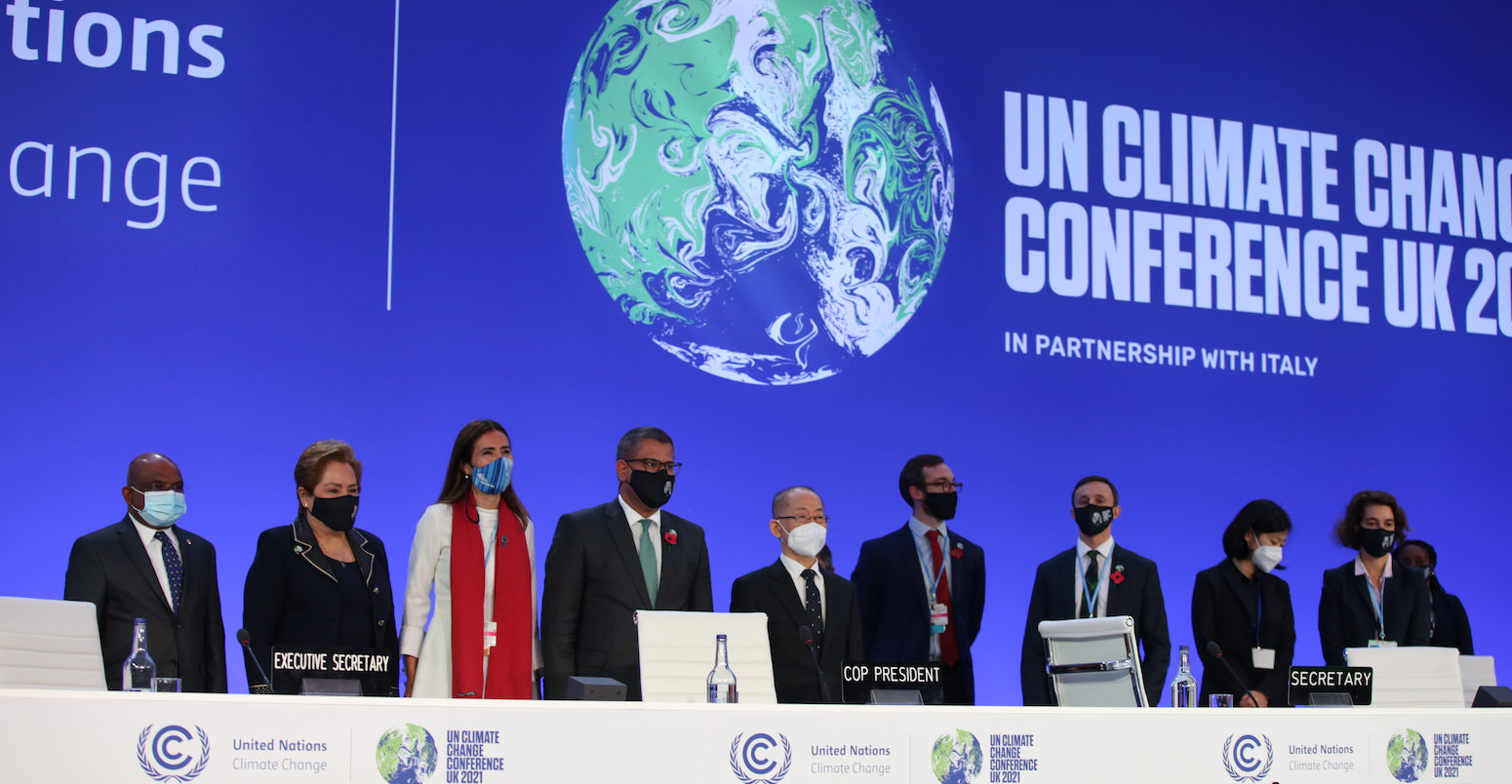
Analysis: Do COP26 promises keep global warming below 2C?
Multiple Authors
11.10.21Multiple Authors
10.11.2021 | 1:39pmDepending on whom you ask, the COP26 climate summit may seem like the best of times or the worst of times.
On the one hand, reports proclaim boldly that limiting global warming to below 2C might finally be in reach. On the other, critics complain that modest improvements on country commitments amount to little more than “blah blah blah”.
The reality is more nuanced. There has been progress made in flattening the curve of future emissions through both climate policies and falling clean energy costs. At the same time, the world is still far from on track to meet Paris Agreement goals of limiting warming to 1.5C or “well below” 2C.
COP26 negotiations have seen a flurry of new reports on what existing and new promises and pledges mean for the climate.
Here, Carbon Brief breaks down these numbers, looking at what they refer to, where different groups agree and disagree on likely outcomes, and the potential impact of new long-term net-zero promises.
The analysis reveals widespread agreement between four different groups assessing the climate outcomes of COP26. They suggest that current policies will lead to a best-estimate of around 2.6C to 2.7C warming by 2100 (with an uncertainty range of 2C to 3.6C).
If countries meet both conditional and unconditional nationally determined contributions (NDCs) for the near-term target of 2030, projected warming by 2100 falls to 2.4C (1.8C to 3.3C).
Finally, if countries meet their long-term net-zero promises, global warming would be reduced to around 1.8C (1.4C to 2.6C) by 2100, though temperatures would likely peak around 1.9C in the middle of the century before declining.
In addition to the revised NDCs, there have been a series of announcements at COP26 – including the Global Methane Pledge and an accelerated coal phaseout, as well as business pledges as part of the Race to Zero campaign. Carbon Brief’s analysis finds that these new announcements – combined with recent updates to NDCs – have likely shaved an additional 0.1C warming off what was implied under commitments out to 2030.
Similarly, India’s new net-zero pledge has reduced projected global temperature rise by around 0.2C – if all countries meet their long-term net-zero promises.
The extent to which the many new and revised targets will be met will depend on whether they are translated into meaningful near-term commitments. So far the lack of stronger commitments for emissions cuts by 2030 creates a “very big credibility gap” for net-zero promises, according to the Climate Action Tracker.
Being unable to bend the emission curve downwards this decade puts huge pressure on the remaining carbon budget for “keeping 1.5C alive”. Taking this pathway implies a heavy reliance on CO2 removal beyond 2030 – with its many feasibility, technological, governance and sustainability risks.
Different types of commitments
Much of the confusion around the various warming projections coming out of COP26 stems from which specific scenario is being referred to. Researchers have tended to focus their efforts on three different potential pathways the world could take over the remainder of the 21st century, given the situation today.
The first of these are current policy scenarios. Current policy scenarios assume that policies enacted into law – along with technological progress – continue into the future, but no new climate policies are enacted between now and the end of the century. These scenarios generally lead to global greenhouse gas (GHG) emissions remaining flat or slightly increasing over the next three decades, before modestly declining by the end of the century.
The second are 2030 commitments. These focus on a world where countries meet their 2030 NDCs and continue to reduce emissions at a similar rate for the remainder of the century, with emissions falling roughly in half by 2100 relative to current levels.
Finally, there are net-zero promises. These try to quantify the emissions impacts of pledges that many countries have recently made to reach net-zero emissions by the mid-21st century.
For example, the US and European Union have pledged to reach net-zero greenhouse gas emissions by 2050, China has pledged to reach net-zero GHG emissions by 2060, while India recently committed to reach net-zero emissions (but not yet specified whether this means CO2 or GHGs) by 2070.
Because few of these net-zero commitments are codified into law today, these reflect promises of long-term action rather than binding commitments. These net-zero promise scenarios also include 2030 commitments in their future warming projections.
Warming estimates
Four different groups have provided newly updated estimates of likely warming outcomes either shortly before or during COP26, with new updates coming out on a near-daily basis. These include the United Nations Environment Programme (UNEP), Climate Action Tracker (CAT), the International Energy Agency (IEA) and Climate Resource (CR), an Australia-based climate analysis group.
The figure below shows how current policy, 2030 commitments and net-zero promises compare between groups – and how they stack up against the five different future warming scenarios featured in the recent sixth assessment report (AR6; grey bars) from the Intergovernmental Panel on Climate Change (IPCC).
(Note that not all groups have analysed all scenarios.)
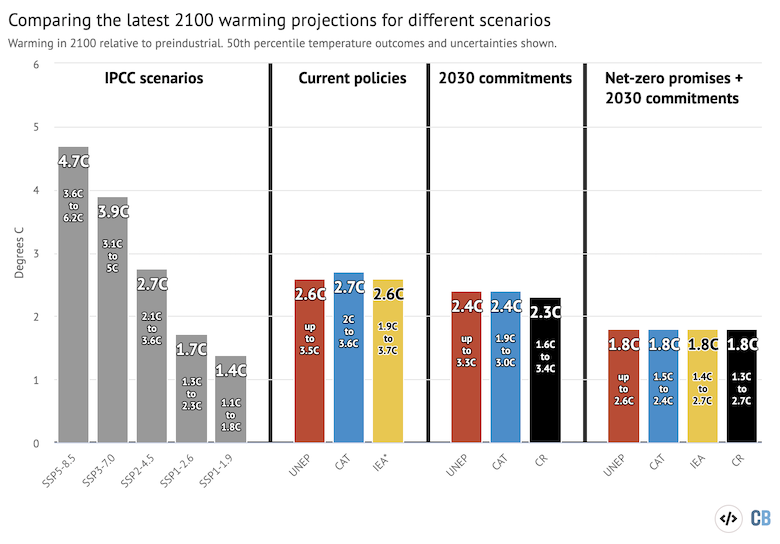
While all of these different scenarios fall well short of limiting warming to below 1.5C by 2100, some progress has been made. Even current policy scenarios are well below the two worst case outcomes – SSP3-7.0 and SSP5-8.5 – explored in the recent IPCC report.
While just seven years ago it seemed quite plausible that the world was on track for around 4C warming by 2100, a combination of climate policies and falling clean energy costs has flattened the curve of future emissions.
However, while some progress has been made, a current policy world of 2.6C or 2.7C warming is still one with potentially catastrophic impacts on human and natural systems. Much more needs to be done to further reduce emissions to meet Paris Agreement goals of limiting warming to “well below” 2C by 2100.
Commitment scenarios for 2030 assume that countries will build on current policies by meeting both “conditional” and “unconditional” NDCs by 2030. This would shave another 0.2C to 0.3C off global temperatures in 2100, resulting in around 2.4C warming.
If countries only meet unconditional NDCs – those that do not depend on financial commitments or actions by other countries – it would result in a best-estimate of around 2.5C warming.
However, CR estimates in its recent report that unconditional NDCs alone could result in up to 2.7C warming, highlighting the challenges of determining warming outcomes implied by NDCs – particularly given the uncertainties in emissions after the 2030 commitment period.
There is also no guarantee that countries will meet their commitments. As UNEP pointed out in its November update to its annual Emissions Gap report, “G20 countries are projected to fall short of achieving their original unconditional NDCs by 1.1GtCO2e [billion tonnes of CO2 equivalent] annually in 2030”.
Finally, if countries meet all of their stated net-zero promises, warming would likely be limited to below 2C – with a best estimate of 1.8C across all the groups providing estimates.
These net-zero promises are long-term commitments by countries to reach a particular goal 30-50 years in the future, when none of the leaders making these promises will still be in office. As only around a dozen of the 74 countries with net-zero commitments have actually formalised them into law, it is unclear how seriously these commitments should be taken or how likely they are to actually be achieved.
Climate system uncertainties
These warming numbers come with some important caveats. First, uncertainties – due to climate sensitivity and carbon cycle feedbacks – are quite large. For example, while current policies are expected to result in around 2.6C to 2.7C warming, the Earth could, in fact, end up with anywhere between 2C to 3.6C or so, depending on how the climate system responds to emissions. These uncertainties are cause for caution and increase the urgency of emissions reductions.
Second, the world does not end in 2100, even though many climate model simulations do. The world will continue warming until global CO2 emissions reach zero (or net-zero) and, even then, will not cool back down for many centuries to come – barring widespread deployment of net-negative emissions to actively suck more CO2 out of the atmosphere than is being emitted. Both current policy and 2030 commitment scenarios do not result in net-zero CO2 emissions before 2100 and would, ultimately, see more warming as CO2 emissions continue into the 22nd century.
Finally, when considering the climate impact of net-zero promises it is important to differentiate between peak warming and 2100 warming. In both CAT and CR modelling of net-zero promises, the world ends up seeing median expected peak temperatures of around 1.9C during the middle of the 21st century, with temperatures falling back down to 1.8C by the year 2100. This is sometimes referred to as an “overshoot”.
There has been a lot of confusion around the 2.7C warming figure, with a number of popular claims that 2030 commitments (NDCs) will lead to around 2.7C of warming by 2100. However, such claims are a little misleading; the original 2.7C number came from a UNFCCC report that simply noted that 2030 emissions values when NDCs were met were similar to – though slightly below – the SSP2-4.5 scenario in the IPCC AR6, and that the SSP2-4.5 scenario has a best-estimate of 2.7C warming by 2100. The UNFCCC report did not do any specific modelling of post-2030 emissions and warming outcomes implied by NDC pledges.
Similarly, while the UNEP report also gave a 2.7C figure for unconditional NDCs, it notes that this is a 66th percentile value. That is to say, UNEP finds that there is a two-in-three chance that warming will be below 2.7C in a world where countries meet their unconditional NDCs, with a median (50th percentile, or one-in-two) estimate of 2.5C (and 2.4C if countries meet both unconditional and conditional NDCs, as shown in the figure above).
UNEP takes a precautionary approach by framing its temperature estimates around a two-in-three avoidance chance, though this tends to create confusion when comparing its estimates to those of other groups.
While it is quite possible that the world could end up at 2.7C (or more) of warming given uncertainties in how the climate responds to our emissions, the various groups all agree that the best estimate of future warming if countries meet all of their 2030 commitments (and do not fall short) is around 2.4C.
The recent CAT update gives two numbers for net-zero promises: 2.1C, which it calls “pledges and targets”, and 1.8C which it calls an “optimistic scenario”. These differ in that the former (2.1C) includes only net-zero targets passed into law or submitted to the UNFCCC in detailed long-term strategies, while the latter (1.8C) includes all net-zero targets that have been announced.
The impact of new COP26 commitments
There have been a number of important commitments made either shortly before or during the COP26 conference this year that have resulted in modestly lower estimates of future warming under both 2030 commitments and net-zero promise scenarios.
These include 31 new updated NDC pledges – particularly those from Saudi Arabia,
non-G20 members, and China – and a new promise by India to reach net-zero emissions by 2070 (although India has yet to formally submit an updated NDC). More than 100 countries representing 70% of the global economy joined together to pledge to cut methane emissions at least 30% below 2020 levels by 2030. Twenty-three countries – including Indonesia, Vietnam, Poland and South Korea – have new pledges to phase-out coal, and a number of countries have made additional commitments to end fossil fuel financing and deforestation.
The Energy Transition Commission (ETC) made the case that the race to zero efforts and additional sector focus on “coal, cars, cash and trees” could help close the 2030 emission gaps for CO2 and methane. Lord Adair Turner, the ETC chair, announced in a special COP event last Friday that deals done in the first week of COP could amount to an additional 6bn tonnes CO2 reduction and 50m tonnes of methane reduction over-and-above the NDCs.
However, analyses by both CAT and Carbon Brief are far less optimistic about how much more in the way of emissions reductions these additional deals provide compared to what is already in the NDCs.
Carbon Brief analysed the climate impacts of the new methane and coal pledges. For methane, the pledge covers 45% of global emissions, but of the signatories the US, Europe and Canada already have strong emission reduction plans in their NDCs that likely exceed pledge commitments. Carbon Brief optimistically assumes a 30% reduction in methane for the remaining signatories, covering approximately 35% of global emissions, somewhat smaller than the ETC estimate.
For coal, both CAT and ETC agree on a 0.2GtCO2 emission saving by 2030 on top of existing NDCs – shown by the black line in the figure below. The bold red line in the chart below shows that these sector deals could bring an additional 0.05C of reduction in global temperature by 2100 beyond existing NDC commitments. The light red line shows Carbon Brief’s “optimistic” analysis.
The effects of fossil-fuel finance and reduced deforestation pledges are more challenging to model, but any additional emissions reductions beyond those already committed to under existing NDCs are expected to be small.
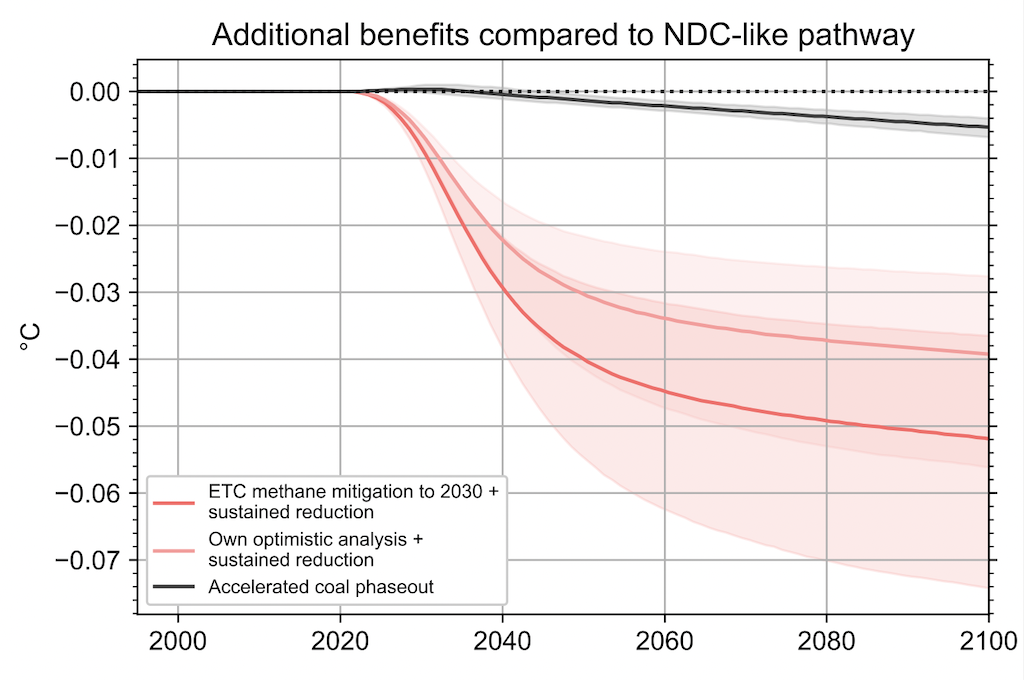
In addition to the ~0.05C reduction in 2100 temperatures expected from methane and coal pledges, recent updates to NDCs also have a modest impact. The recent UNEP emissions gap update suggests that commitments made immediately before or during the COP26 summit are expected to reduce global emissions in 2030 by an additional 0.5GtCO2e for unconditional NDCs and 1.5GtCO2e for when conditional NDC updates are included.
Taken together, Carbon Brief estimates that these pledges and NDC updates would – if fully implemented – reduce global temperatures by around 0.1C relative to 2030 commitments in place prior to COP26.
The figure below shows the progression of warming outcomes for 2030 commitments in 2020 (in red; prior to NDC updates over the past year), before COP26 (orange) and with new commitments made around COP26 (yellow). It also includes updates to 2100 temperature outcomes of net-zero promises (light and dark blue) which primarily reflect the impact of India’s new net-zero promise.
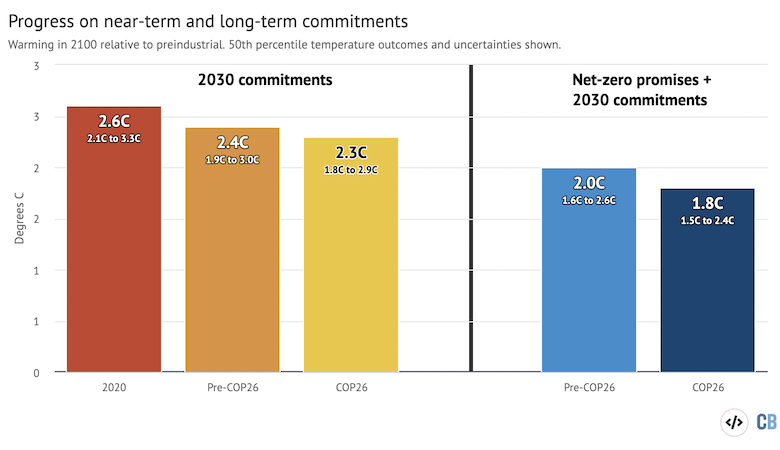
This estimate – that new pledges around COP26 will reduce warming from 2030 commitments by an additional 0.1C – is similar to recent findings by both UNEP and CR.
The new net-zero promises result in 2100 warming of 1.8C that – if achieved – would mean that the world would have at least a two-in-three chance of avoiding 2C warming by 2100. But it is necessary to be cautious about giving too much weight to these long-term promises until they are more strongly reflected in near-term commitments.
‘Very big credibility gap’ for net-zero pledges
The IEA’s announcement last week that announced pledges now result in under 2C warming by 2100 was met with a cautious welcome from some and scepticism from others. This represents the first time countries have collectively pledged to a net-zero timeline that would likely (~66% chance) avoid 2C warming in 2100. Other groups – including CAT, CR and UNEP – have since found similar results in reports this week.
Net-zero promises from 74 countries now cover at least 76% of global GHG emissions. However, only 12 of these are actually reflected in law today. There remains quite a lot of ambiguity around net-zero pledges in terms of what is included – for example, fossil CO2 emissions, all CO2 emissions or all GHGs emissions – and what, if any, interim targets will be met.
It is important not to conflate these long-term ambitions with the more firm near-term actions pledged by countries under their 2030 NDCs. There remains a large disconnect between more modest near-term 2030 commitments and extremely ambitious long-term 2050 to 2070 commitments.
As Inger Andersen, executive director of the UNEP, told COP26 delegates on Tuesday:
“It is not good to see that net-zero pledges are generally vague and untransparent; they are hard to calculate and hold to account; many kick the can beyond 2030, when we know that we need to halve our emissions between now and 2030 to be on track to limit warming to 1.5C.”
Similarly, Claire Stockwell, senior climate policy analyst at Climate Analytics and part of the CAT team, told delegates:
“It is all very well for leaders and governments to claim that they have a net-zero target, but if they don’t have plans as to how to get there, and their 2030 targets are not aligned with net-zero, then, frankly, these net-zero targets are just paying lip service to real climate action. That’s the key reason we think Glasgow at this stage has a very big credibility gap.”
Big emissions gap remains for 1.5C
To have a reasonable chance of limiting warming to 1.5C by 2100, global emissions need to fall roughly in half by 2030. While country commitments around COP26 have modestly reduced warming outcomes and projected 2030 emissions, a massive gap still remains. Or, as Andersen puts it, these new near-term commitments are, “frankly, an elephant giving birth to a mouse”.
The figure below – adapted from the 2021 UNEP Emissions Gap report, which has been updated with the latest estimates – shows emissions trajectories associated with current policies (orange line), unconditional (yellow) and conditional (light blue) NDCs, and pathways consistent with staying below 2C (dark blue), 1.8C (purple) and avoiding 1.5C (grey).
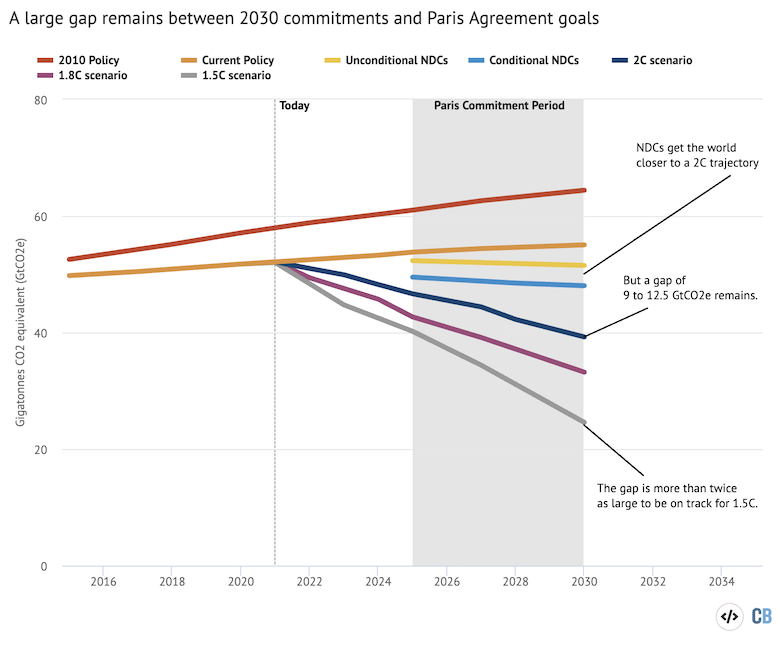
While net-zero promises are – at least on paper – consistent with limiting warming below 2C by 2100, the fact that these promises are not reflected in tangible near-term commitments is concerning and increases the risk that they may not, in fact, be achieved. And even if net-zero promises were met, they would still fall short of the Paris Agreement goal of pursuing efforts to limit the temperature increase to 1.5C.
Following a flat CO2 emissions trajectory to 2030 of around 40GtCO2 per year nearly exhausts the 460GtCO2 remaining carbon budget, estimated at the start of 2021 for staying below 1.5C with 50% likelihood.
Unless the emission curve can be bent down this decade, a flat emission trajectory locks in a reliance on net-negative emissions in the future – and brings into play their many risks around feasibility, governance and sustainability. Long-term net-zero promises by countries are less likely to be met unless there is a tangible increase in the strength of near-term commitments, and so far COP26 has proven to be long on promises and short on near-term action.
This article was co-written by Dr Zeke Hausfather, Carbon Brief’s climate science contributor, and Prof Piers Forster, professor of climate physics at the University of Leeds and director of the Priestley International Centre for Climate.
Dr Chris Smith, senior research fellow in the Priestley International Centre for Climate at the University of Leeds and the International Institute for Applied Systems Analysis (IIASA), contributed to the analysis translating the new methane and coal phaseout commitments into warming impacts.
-
Analysis: Do COP26 promises keep global warming below 2C?
-
How much will the world warm if COP26 promises are met?

